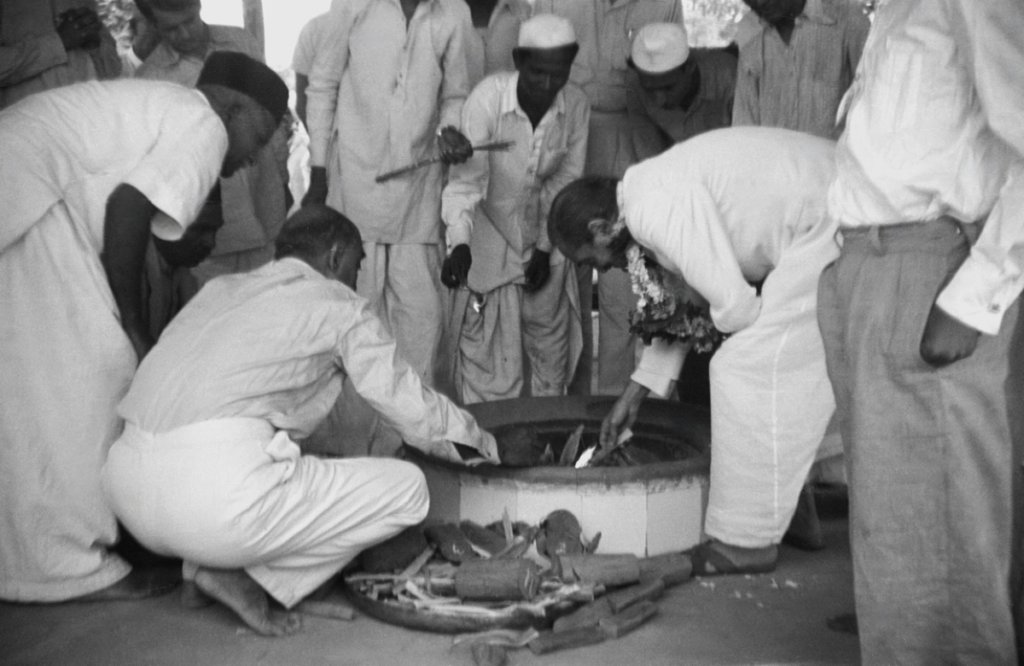
November 27, 2021
The Fire of Divine Love
After the first dhuni was lit in Meherabad in 1925, Meher Baba asked each of His Mandali to write a poem about the dhuni. Many poems were written; however, the poem that continues to define the power and nature of the dhuni was composed by Baba Himself. Baba personifies the dhuni as if she were a mythical creature holding great power even over God Himself. Like all legends, she has a magical flair that elicits mystery, awe, and ancient reverence.
Baba writes,
My pen has not the strength to sing your praise.
At the first glow of your flame there was rain!
How marvelous is your gift!
To cool your radiant blaze, God Himself, in honor of you,
Showered rain for hours on end.
In the early monsoon of 1925, there was a scarcity of water in the areas neighboring Meherabad. If further rain failed, the prospect came with a danger to the livelihood of the farmers. Padri explains, “This secondary—September rains are very essential, for, during this period the major crops of jowar, (milo) wheat, gram etc. are sown. These crops are most helpful to the farmers because they give the farmers their staple grain plus animal fodder in plenty. And since the primary current was feeble, the crops had failed in many places, in fact the primary crop was almost lost. Now, if the secondary current also failed there would be drought.” [1]
Some farmers from far-off villages came as a group in a bhajan party, singing bhajans to Baba invoking Him to do something in His power. In all His compassion Baba heard their plight but advised them to be patient and go home.
Baba ordered for a dhuni to be lit. Preparations were made—sandalwood and ghee (clarified butter) were accumulated, and a shallow pit dug in the ground. The concept of dhuni fire was not new in India. “Dhuni fire has always a very shallow pit to receive the glowing coals which, ultimately turns to ashes which has its own value for the devotees, to be applied to the forehead and to be taken home to be distributed amongst others as it comes from a saintly abode,” Padri clarifies. [2]
Upasani Maharaj’s arti was sung by the Mandali as the flames rose to the clear blue skies. When the arti was almost half over, it began to drizzle which in turn developed into a very good shower, cooling the earth and drenching not only the Master and the Mandali, but also the villagers who were on their way home. The showers lasted for fifteen hours and the crops were saved—prayers of love and faith answered.
The whole region of Ahmednagar was without water.
But at the perfect time you rewarded the labor of the farmer.
In the form of fire you were hot.
By becoming water you were cool.
On December 12, 1941, Baba indicated that this time the dhuni was being lit for His internal work and not to bring rain. A month later, on January 12, 1942, Baba ordered for the dhuni to be lit every month at Meherabad. Since then, His wish has certainly been kept. Rain or shine, the dhuni is lit at sundown in Meherabad. The current platform around the pit was built in 1948.
At the Three Incredible Weeks in 1954, Baba explained that a stick of sandalwood should represent a particular desire that one wishes to consecrate and burn to ashes. During the 1955 Sahavas, Baba said, “On the 12th of every month a dhuni is lit, and today at six o’clock we will be present there. The human mind is full of infinite thoughts. This mind is finite, but its thoughts are infinite. So, burn your desires and thoughts in the dhuni today. At least let one thought of either lust, greed or anger be burnt in it.” [3]
Fire has spiritual significance in various world religions leading to fire rituals that have evolved over time. One of Baba’s Perfect Masters, Sai Baba of Shirdi, was famous for the inextinguishable dhuni he lit upon settling in Shirdi. Zoroastrianism and Hinduism hold fire as key symbols. Baba’s dhuni is unique in its natural focus on the sacred, consumptive power of fire. It is a symbol of the fire of divine love and its power to burn the false self in order to unite with the real Self.
When you have surrendered to Baba, let your lips be sealed.
Brave are those who serve at the feet of the Sadguru.
Limitless is your greatness,
O Dhuni! [4]
Eruch captures the true essence of the dhuni when he says, “But the real dhuni is the human heart. And the real fire is the fire of love for God. And if we had the courage, the daring, every day, every moment, we would be attempting to throw our attachments on this fire. Not just attachments, we would be throwing ourselves onto this fire. That would be the real dhuni.” [5]
[1] Letters from the Mandali of Avatar Meher Baba, p. 115-116
[2] Ibid.
[3] Lord Meher Online Edition, p. 3777
[4] Lord Meher Online Edition, p. 623-624
[5] That’s How it Was, by Eruch Jessawala, p. 340